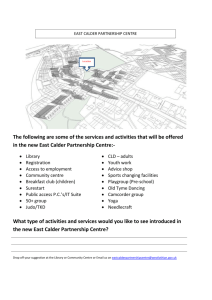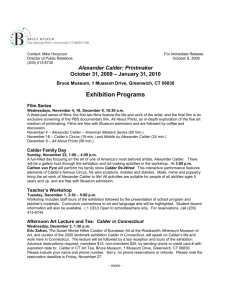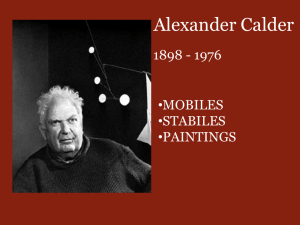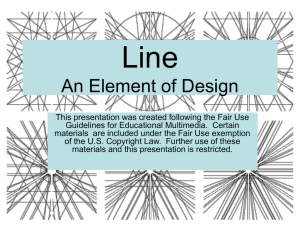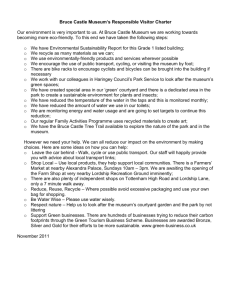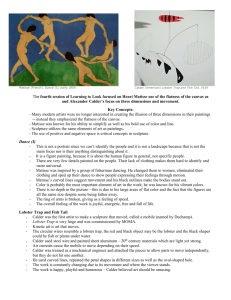Alexander Calder (1898-1976)
advertisement
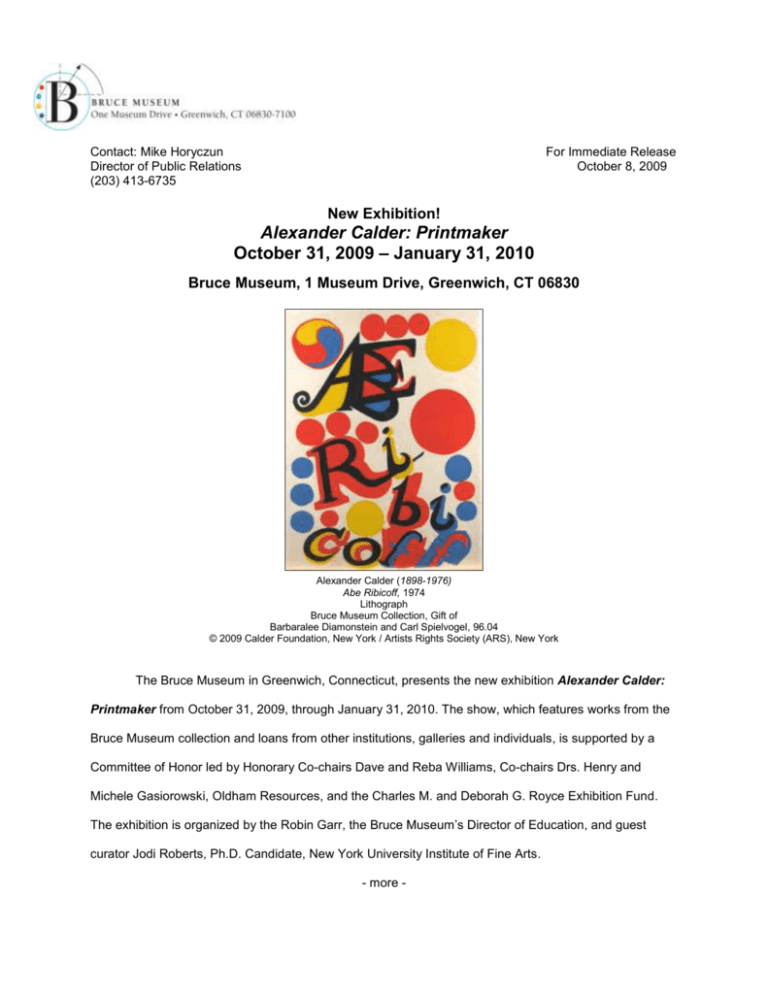
Contact: Mike Horyczun Director of Public Relations (203) 413-6735 For Immediate Release October 8, 2009 New Exhibition! Alexander Calder: Printmaker October 31, 2009 – January 31, 2010 Bruce Museum, 1 Museum Drive, Greenwich, CT 06830 Alexander Calder (1898-1976) Abe Ribicoff, 1974 Lithograph Bruce Museum Collection, Gift of Barbaralee Diamonstein and Carl Spielvogel, 96.04 © 2009 Calder Foundation, New York / Artists Rights Society (ARS), New York The Bruce Museum in Greenwich, Connecticut, presents the new exhibition Alexander Calder: Printmaker from October 31, 2009, through January 31, 2010. The show, which features works from the Bruce Museum collection and loans from other institutions, galleries and individuals, is supported by a Committee of Honor led by Honorary Co-chairs Dave and Reba Williams, Co-chairs Drs. Henry and Michele Gasiorowski, Oldham Resources, and the Charles M. and Deborah G. Royce Exhibition Fund. The exhibition is organized by the Robin Garr, the Bruce Museum’s Director of Education, and guest curator Jodi Roberts, Ph.D. Candidate, New York University Institute of Fine Arts. - more - 2 Alexander Calder’s many sculptural inventions—including his famed Cirque Calder, his imposing stabiles and, most importantly, his graceful mobiles—have secured his place among America’s most celebrated artists. Yet critical and public praise of Calder’s sculpture has drawn attention away from his career-long devotion to other media. In an effort to uncover one of the artist’s lesser-known artistic practices, the Bruce Museum’s exhibition Alexander Calder: Printmaker brings together 28 prints made throughout Calder’s career, affirming his continual interest in printmaking processes and proficiency in numerous printing techniques. A degree of stylistic and iconographic continuity exists among Calder’s prints, but they served diverse purposes. Comprised of literary illustrations, poster designs, studies related to sculptures and paintings, and ostensibly independent compositions, the artist’s prints intersect with his more famous works while also providing insight into his working process and extra-artistic concerns. Born in a suburb of Philadelphia to a family of artists, Calder spent the majority of his childhood in Pasadena, California. He received a degree in mechanical engineering from New Jersey’s Stevens Institute of Technology in 1919, but by 1922 he had abandoned this early career path. Calder opted instead to enter the Art Students League of New York in 1923, where he took classes on etching and lithography. In order to support himself while living in New York City, Calder took a job as an illustrator for the National Police Gazette and produced lively sketches of local entertainments for the magazine. The sparse lines and sense of spontaneity that characterize his commercial illustrations find echoes in Calder’s earliest prints, several of which are included in the exhibition. Calder picked up his study of printmaking after moving to Paris in 1926. There, he met nowfamous members of the early 20th-century avant-garde, including Joan Miró, Fernand Léger, Piet Mondrian and Marcel Duchamp. He also befriended Stanley William Hayter, widely considered to be one of the most influential printmakers of the 20th century. The Bruce Museum’s show highlights the mutual exchange and lasting friendship enjoyed by both artists through its inclusion of three Calder prints that issued from an edition created at Hayter’s. - more - 3 Calder returned to the United States in 1933 and established a home base in Roxbury, Connecticut, although he retained strong connections to the Parisian art world. A mid-career retrospective at the Museum of Modern Art in 1943 cemented his status as an artist of international stature. In 1952, he represented the United States at the Venice Biennale and was awarded the grand prize for sculpture. Soon thereafter, he acquired a home in Sache, France and began to spend major portions of the year working abroad. As Calder’s professional reputation erupted in the late 1940s and 1950s, so did his production of prints. Masses of lithographs based on his gouache paintings hit the market, and deluxe editions of plays, poems, and short stories illustrated with fine art prints by Calder became available for sale. Visitors will find ample examples of Calder’s late print work in this exhibition. The role of printmaking in an artist’s career is often complicated as it raises questions of an image’s function, intended audience, and authenticity. Alexander Calder: Printmaker offers the opportunity for both an in-depth exploration of his particular body of works and an analysis of larger issues surrounding the production, use, and distribution of fine art prints. The Bruce Museum is located at 1 Museum Drive in Greenwich, Connecticut, near Interstate-95, Exit 3, and a short walk from the Greenwich, CT train station. Museum hours are: Tuesday through Saturday 10 a.m. to 5 p.m., Sunday 1 p.m. to 5 p.m., and closed Mondays and major holidays. Admission: $7 for adults, $6 for seniors and students, and free for children under five and members. Free admission to all on Tuesdays. Groups of eight or more require advance reservations. Museum exhibition tours are held Fridays at 12:30 p.m. Free, on-site parking is available. The Bruce Museum is accessible to individuals with disabilities. For information, call the Bruce Museum at (203) 869-0376, or visit the Bruce Museum website at www.brucemuseum.org. *****
